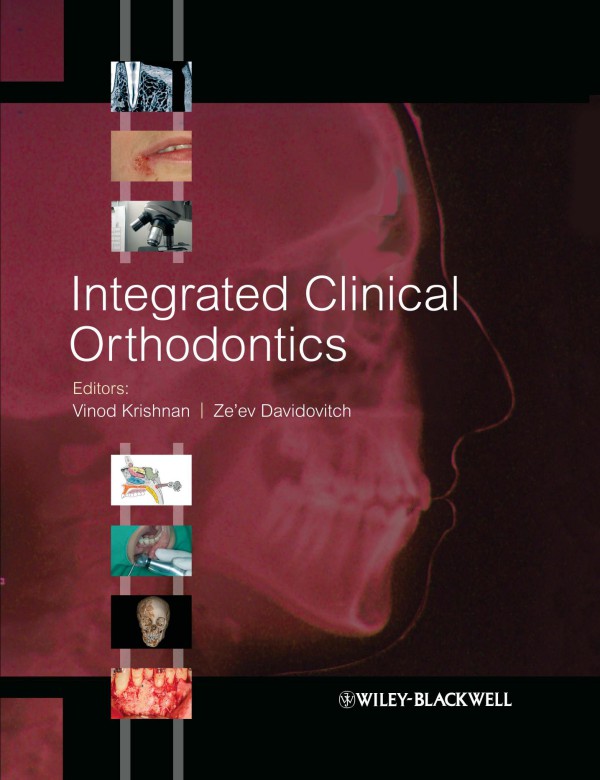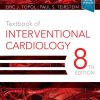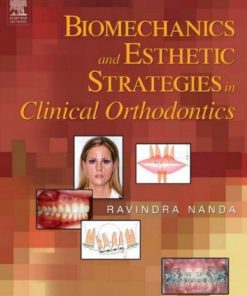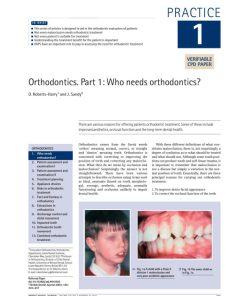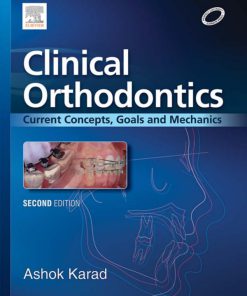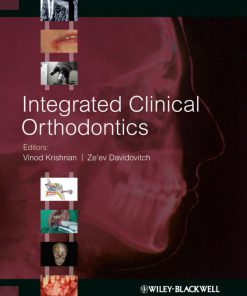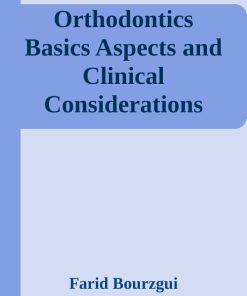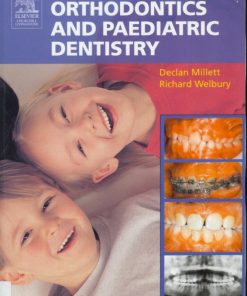Integrated Clinical Orthodontics 1st edition by Vinod Krishna, Ze’ev Davidovitch ISBN 1444398618 9781444398618
$50.00 Original price was: $50.00.$25.00Current price is: $25.00.
Authors:Vinod Krishnan; Ze’ev Davidovitch , Author sort:Krishnan, Vinod & Davidovitch, Ze’ev , Published:Published:Oct 2011
Integrated Clinical Orthodontics 1st edition by Vinod Krishna, Ze’ev Davidovitch – Ebook PDF Instant Download/Delivery. 1444398618, 978-1444398618
Full download Integrated Clinical Orthodontics 1st Edition after payment
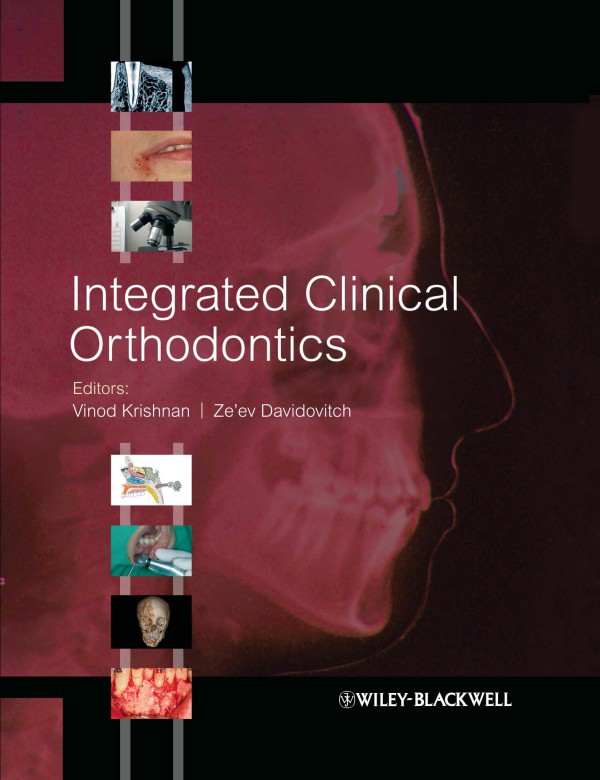
Product details:
ISBN 10: 1444398618
ISBN 13: 978-1444398618
Author: Vinod Krishna, Ze’ev Davidovitch
This is an important new resource on the clinical interactions between the practice of orthodontics and other areas of clinical dentistry and medicine. Focusing on patient-centred care, the book integrates the knowledge, skills and experience of many different dental and medical disciplines to help orthodontists arrive at an accurate diagnosis and a comprehensive treatment plan.
In a highly visual and practical format, Integrated Clinical Orthodontics uses clinical case presentations to illustrate the rationale and application of the integrated approach to a variety of clinical scenarios, including congenital orofacial deformities, sleep disorders, otorhinolaryngologic, pediatric and temporomandibular joint problems. The book also details specific protocols for effective communication with experts in other specialties, and focuses on the role of the orthodontist as a member of a multi-disciplinary team.
KEY FEATURES
• Emphasises the interaction between orthodontics and other dental and medical specialties
• Discusses the role of the orthodontist in a multi-disciplinary team
• Focuses on patient-centred care
• Presents information in the form of clinical case scenarios
• Includes many high quality full color clinical photographs
• Written by a range of international experts
Integrated Clinical Orthodontics 1st Table of contents:
Part I: Diagnosis, Psychology, and Genetics
Chapter 1: The Increased Stature of Orthodontics
- The broadening scope of orthodontics
- The orthodontic patient as a human being
- The patient’s biological status: does it influence orthodontic treatment?
- Conclusions
Chapter 2: Orthodontic Diagnosis and Treatment Planning: Collaborating with Medical and Other Dental Specialists
- The other side of the story
- Orthodontic diagnosis from a broad perspective
- The first interaction with the patient
- The importance of the medical history in orthodontic diagnosis and treatment planning
- Overview of systemic disturbances in relation to orthodontic treatment planning
- Identifying local dental abnormalities before attempting orthodontic treatment
- Evaluation of the occlusion and the temporomandibular joint
- Radiographic examination of the craniofacial region
- Conclusion
Chapter 3: Psychosocial Factors in Orthodontics: Patient Perceptions, Motivation, and Expectations
- Motivation for orthodontic treatment
- Treatment expectations
- Perception of malocclusion
- Patients with psychological disorders
- Orthognathic patients
- Patients with orofacial clefts and craniofacial anomalies
- Patients with acquired deformities
- Conclusions
Chapter 4: Integrated Clinical Genetics/Syndromology for the Orthodontist
- Interaction with the clinical geneticist
- Evolution of the clinical geneticist specialist
- When to refer
- Artificial intelligence and facial analysis
- Selected syndromes and conditions
- Radiographic signs
- History of premature tooth exfoliation
- Conditions in which premature tooth exfoliation may occur occasionally
- Supernumerary teeth and hypodontia (oligodontia)
- Syndromic hypodontia
- Supernumerary teeth or hypodontia (oligodontia) and cancer
- Failure of dental eruption
- Soft and hard tissue asymmetry
- Maxillary hypoplasia
- Functional (neuromuscular) asymmetry
- Mandibular retrognathism
- Connective tissue dysplasia
- Cleft lip and cleft palate
- Additional resources
Part II: The Growing Patient
Chapter 5: Endocrinological Conditions and Orthodontic Treatment
- Growth hormone disorders
- Thyroid disease
- Parathyroid gland disorders
- Primary adrenal insufficiency
- Fibrous dysplasia
- Diabetes mellitus
- Sex-specific endocrine disorders
- Exogenous hormone administration
- Conclusions
Chapter 6: Nutrition in Orthodontic Practice
- The importance of diet and nutrition in oral health
- Dietary habits
- Nutrition and oral health
- Orthodontic guide to performing nutrition risk assessments
- Conclusion
Chapter 7: Cleft Lip and Palate: Role of the Orthodontist in the Interdisciplinary Management Team
- Interdisciplinary team care
- Members of the cleft lip and palate team and their roles
- Orthodontic management
- Conclusion
Chapter 8: Multidisciplinary Management of Craniofacial Malformations
- General principles in the diagnosis and management of craniofacial malformations
- Otofacial malformations
- Craniosynostosis
- Conclusion
Part III: Enhancing the Envelope of Orthodontic Care: The Medical Collaboration
Chapter 9: What Can Orthodontists Learn from Orthopedists Engaged in Basic Research?
- A common language
- Bone adaptation to mechanical deformation and orthodontic tooth movement
- Bone reaction to skeletal anchorage
- Conclusion
Chapter 10: Acute and Chronic Infections Affecting the Oral Cavity: Orthodontic Implications
- Bacterial infections
- Viral infections
- Fungal infections
- Parasitic infections
- The oral cavity as a source for focal infections
- Conclusions
Chapter 11: Unveiling and Managing Upper Airway Problems in the Orthodontic Patient
- The spectrum of sleep-disordered breathing
- Decoding obstructive sleep apnea
- Respiration: Effect of anatomy and sleep
- The child with sleep-disordered breathing
- The adult with sleep-disordered breathing
- Cephalometrics and imaging
- Orthodontic management
- Surgical management
- Conclusion
- Acknowledgments
Chapter 12: Interaction between the Orthodontist and Medical Airway Specialists on Respiratory and Nonrespiratory Disturbances
- The mouth in relation to the nasopharyngeal airway: Anatomy overview
- Common sources of airway dysfunction
- Nonrespiratory areas of interaction with ENT specialists
- State of interaction between orthodontists and medical airway specialists
Chapter 13: Neuromuscular Diseases and the Orthodontist
- Myotonic dystrophy
- Duchenne muscular dystrophy
- Other neuromuscular diseases
- Conclusions
Chapter 14: Orthodontics for Children with Disabilities
- Therapeutic access
- Pretreatment visits, patient assessment, and future management
- Orthodontic records
- Overall treatment plan
- Relapse and retention
- Case descriptions
- Conclusion
Chapter 15: Orthodontic Care in the Adult Medically Compromised Patient
- Cardiovascular disorders
- Endocrine disorders
- Infectious diseases
- Skeletal system problems
- Gastrointestinal disorders
- Respiratory system problems
- Nervous system disorders
- Renal disorders
- Allergy reactions
- Conclusion
Part IV: Orthodontics and Other Dental Specialties
Chapter 16: Comprehensive Periodontal Evaluation of the Orthodontic Patient: The Role of a Periodontist in Orthodontic Practice
- Pathological tooth migration
- Treatment plan
- Goals of periodontal therapy
- Comprehensive periodontal examination
- Case presentations
- Acknowledgments
Chapter 17: The Restorative Dentist and Orthodontist: Orthodontic Implications of Dental Caries, Tooth Fracture, Exposed Dental Pulp, and Esthetic Improvements
- Pretreatment evaluation and early stages of the orthodontic treatment
- Interactive collaboration during orthodontic treatment
- Emergency orthodontic treatment in trauma cases
- Immediate postorthodontic period
- Esthetic improvements
- Conclusion
Chapter 18: Orthodontics and Pediatric Dentistry: Two Specialties, One Goal
- Coordinating orthodontic and pediatric dental appointments in a group or solo practitioner setting
- Identifying orthodontic and pediatric dental problems earlier rather than later
- Restoring form and function: Revisiting the unilateral posterior crossbite with a functional mandibular shift
- Congenitally missing maxillary lateral incisors: Who does what, when, and how?
- Retention considerations and beyond
- Enamel demineralization during orthodontic treatment: Who takes responsibility for prevention?
- Conclusions
Chapter 19: Optimizing Prosthodontic Care with Orthodontic Mechanotherapeutics
- Pre-prosthodontic management of intraarch spaces
- Pre-prosthodontic management of interarch spaces
- Correction of ridge deformity through orthodontic tooth movement
- Restorative treatment before orthodontics (means for tooth movement)
- Conclusion
Chapter 20: Integrated Management of the Orthognathic Patient
- Multidisciplinary Team
- Systematic approach
- Orthognathic surgery
- Stability and relapse
- Follow-up
- Digital innovations in orthognathic surgery
- Conclusion
Chapter 21: The Role of the Orthodontist in Managing Disorders of the Temporomandibular Joint
- Why should orthodontists deal with the temporomandibular joint?
- Anatomy of the temporomandibular joint
- Should orthodontists care about condylar position?
- Temporomandibular joint disorders
- Joint pain: Arthralgia
- Disc disorders
- Occlusal changes due to temporomandibular disorders
- Congenital/developmental disorders
- Conclusion
Part V: The Biomedical Orthodontist
Chapter 22: The Role of Biomedical Engineers in the Design and Manufacture of Orthodontic Appliances
- Past research activities
- Current research activities and potential future applications
- Conclusions
Chapter 23: Designing and Manufacturing Customized Orthodontic Appliances
- Orthodontic imaging and analysis software
- Surface and volume scanning
- Orthodontic computer-aided design software
- Three-dimensional manufacturing
- Customized orthodontic appliances
- Clear aligners
- Selective laser sintering and metallic orthodontic appliances
- Customized orthodontic brackets
- Conclusion
Chapter 24: Regenerative Medicine in Orthodontic Therapy
- Principles of tissue regeneration
- Stem cell basics
- Impact of regenerative medicine in dentistry and orthodontics
- Orthodontics and dentofacial orthopedics as clinical motivation for tissue engineering
- Conclusion
- Acknowledgments
Chapter 25: Artificial Intelligence and Orthodontic Practice: The Future Unveiled
- Applications of artificial intelligence technology in orthodontics
- Artificial intelligence–driven remote monitoring
- Blockchain technology in healthcare
- Ethical considerations in artificial intelligence
- References
Chapter 26: The Seven Pillars of Professionalism
- The Seven Wonders of the World
- The concept of professionalism
- The seven pillars of professionalism
- Our public image of professionalism
- Now, what about those Seven Wonders of the World: Where are they now?
People also search for Integrated Clinical Orthodontics 1st:
interincisal angle orthodontics
center for integrative orthodontics st charles il
types of archwires in orthodontics
integrated clinical experience
limited interceptive and comprehensive orthodontic treatment
You may also like…
eBook PDF
Atlas of Advanced Orthodontics A Guide to Clinical Efficiency 1st edition by Roberts Harry, Sandy

